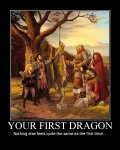(Psi)SeveredHead
Adventurer
I started playing D&D at age 13. It's currently written 12+.
Making it too kid-friendly would turn away adults.
Because it's a game often played by people under 18 living with their parents, I think we can't avoid censorship. We don't want to make the parents uncomfortable. The deck is already stacked against the hobby when it comes to some parents.
Making it too kid-friendly would turn away adults.
Because it's a game often played by people under 18 living with their parents, I think we can't avoid censorship. We don't want to make the parents uncomfortable. The deck is already stacked against the hobby when it comes to some parents.





